Apple's third-generation shuffle was announced just yesterday with 4GB of storage and a new aluminum design that's smaller than a AA battery. The controls, somewhat controversially, have been moved to the earbud cord, with VoiceOver speech technology for navigation.
The Apple teardown experts at iFixit have posted their first look at the new shuffle, observing that a single MacBook Pro 17" weighs as much as 286 of the miniscule players. Even more tiny is the battery, about the size of a dime, with a 73 mAh capacity representing less than half the size of the power reservoirs used in previous shuffles. The weight of the entire shuffle is less than 11 grams, and the rear cover and clip by themselves weigh as much as the rest of the components.
As part of its examination, the iFixit team found the new third-generation shuffle isn't compatible with the second generation dock, nor did the third-generation cable work with a second-generation iPod shuffle.
"Interestingly enough, normal headphones can still be used to listen to music," the solutions provider says. "The only drawback: without Apple's proprietary headphone playback control, you will not be able to change songs or adjust the volume."
Before taking it apart, the technicians couldn't resist placing the diminutive device into a police line-up for a size comparison against a quarter, nickel, dime, PEZ dispenser, SanDisk flash drive, and paper binder clip. While it's not the row's smallest suspect, the shuffle is certainly guilty of being significantly shorter than the dedicated flash drive and just slightly taller than the binder clip.
"We begin by inserting a metal spudger into a crevice between the rear cover and the rest of the shuffle," iFixit wrote. "Inserting the metal spudger creates a gap big enough to insert an iPod opening tool." Sliding the tool across the length of the gap dislodges the left side, then the same procedure is applied to the other side to pry the device open. Once inside, the team was impressed with the clean, simplified interior design ("Is this the future? A single IC, a battery, and some user interface components").
With the outer casing removed, the electronics and battery weigh just four grams, or less than a single sheet of paper. While it's a little bit of a challenge to separate the two halves, once inside there's only one screw to remove.
iFixit noted the back aluminum cover is "fairly easy to bend," recommending caution whenever dealing with that part. With the full shuffle taken apart, the CPU, RAM, and 4GB of flash memory can be seen on a multi-layered stack connected to the battery, while the headphone jack and shuffle switch come out as one unit. According to a stamp inside the casing, the device appears to have been built on March 3rd, meaning iFixit's lucky shuffle had been assembled no more than nine days before being dismantled.
Below are all of the internals ("There are not many parts in this iPod") laid out for comparison with a dime the iFixit team said they found inside (geek humor).
For the full disassembly guide, complete with additional details and photos, is available at iFixit's website.
 Zach Spear
Zach Spear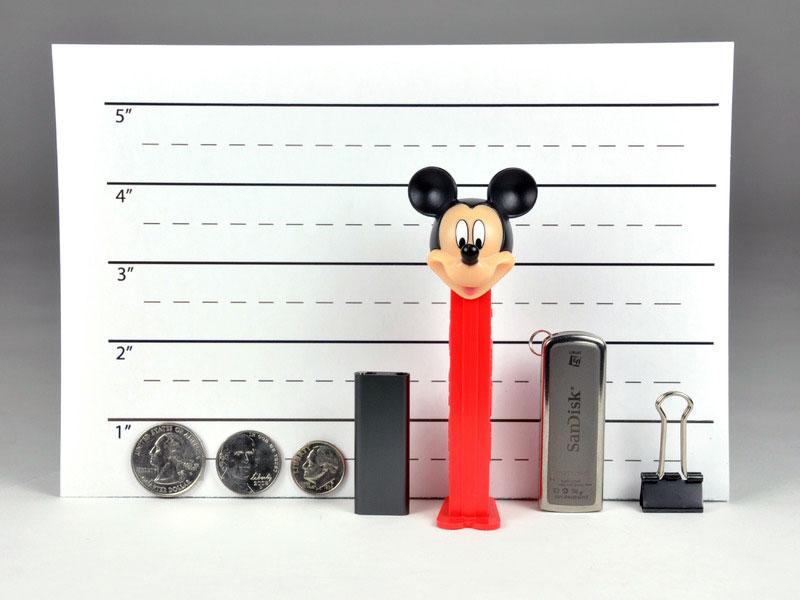
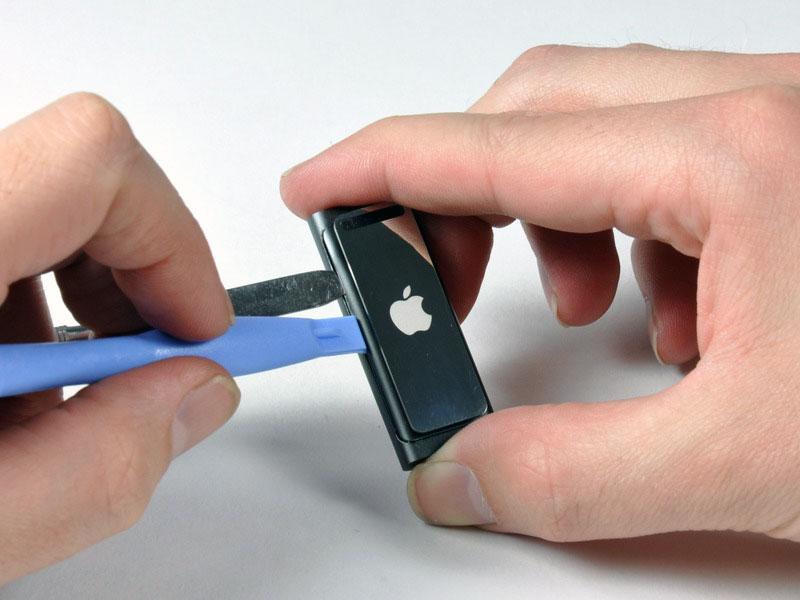
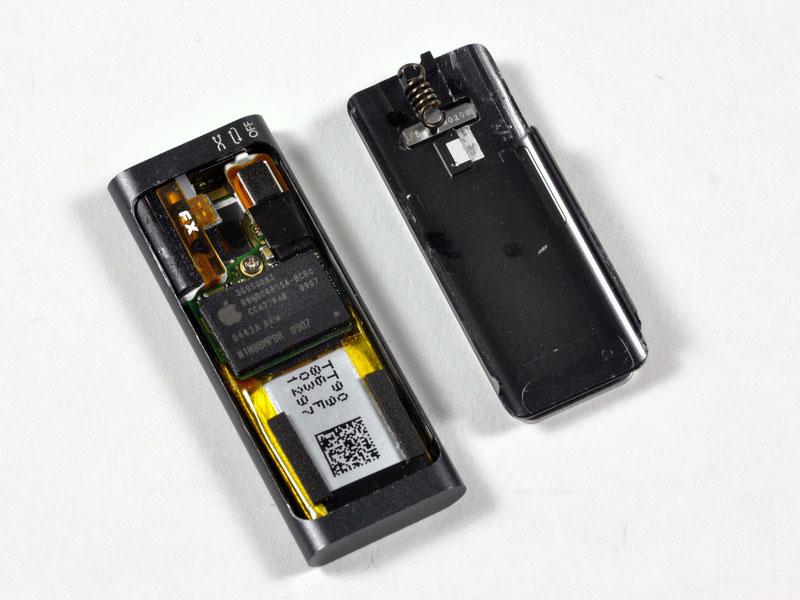
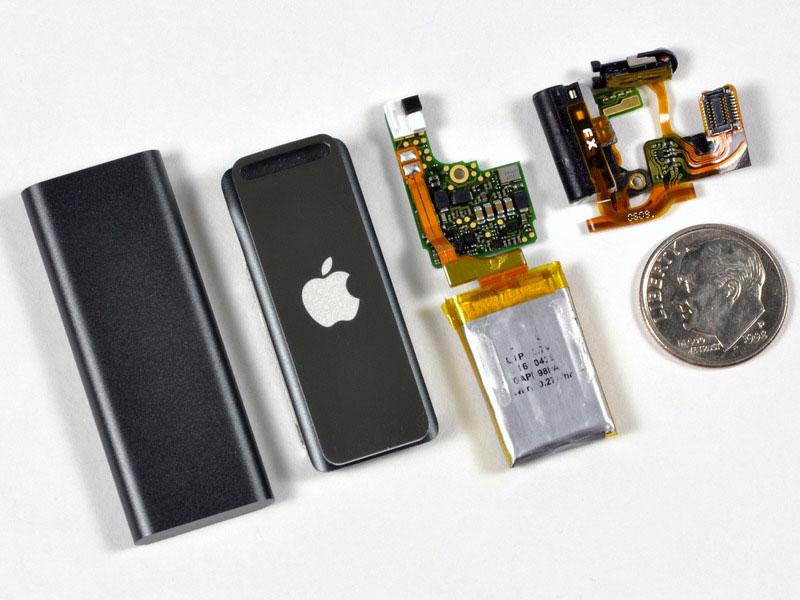







-m.jpg)






 Charles Martin
Charles Martin
 Marko Zivkovic
Marko Zivkovic
 Andrew Orr
Andrew Orr
 Amber Neely
Amber Neely

 William Gallagher and Mike Wuerthele
William Gallagher and Mike Wuerthele


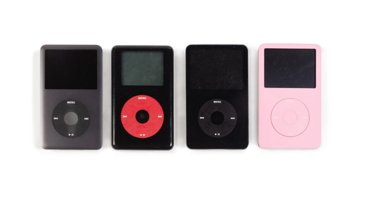








81 Comments
there still space inside! quite cool, mr. Ive!
however, wouldn't the chrome clip be fingerprinted all the time?
This is impressive for such a small device. The CPU is an ARM 8442A, does anyone know how fast it is? If so, do you also know how fast the 2G CPU is? I'm curious to see what HW differences have made it possible to play Apple Lossless, which is new to the iPod Shuffle.
edit: I think RAM is probably the most important aspect for such large files. So, does anyone know the RAM for the new and old Shuffles?
there still space inside! quite cool, mr. Ive!
Apple measures the "true volume" which deletes open space of the headphone jack, the voids inside, etc. I wonder if other players measure their volume that way.
I'm sick of dealing with my iPhone while riding my bike - I'm getting the new shuffle just for that.
"As part of its examination, the iFixit team found the new third-generation shuffle isn't compatible with the second generation dock, nor did the third-generation cable work with a second-generation iPod shuffle."
That's just crazy! I guess now we know why they had to add a 5th USB port to the Mac mini. For all the different dock cables you need for your iPods. I was considering buying a 2nd shuffle, this seals the deal that it'll be a previous generation."Interestingly enough, normal headphones can still be used to listen to music," the solutions provider says. "The only drawback: without Apple's proprietary headphone playback control, you will not be able to change songs or adjust the volume."
So then you can't really use normal headphones, now can you. Not in any practical sense.
"As part of its examination, the iFixit team found the new third-generation shuffle isn't compatible with the second generation dock, nor did the third-generation cable work with a second-generation iPod shuffle."
That's just crazy! I guess now we know why they had to add a 5th USB port to the Mac mini. For all the different dock cables you need for your iPods. I was considering buying a 2nd shuffle, this seals the deal that it'll be a previous generation.
Apple sells more notebooks than desktops and those didn't get any more USB, and actually lost FW400, so I doubt that is the reason for the addition.
This was to be expected since the device charges and syncs through the headphone jack and the connectors had to be changed to allow input from the headphone cable. You might think that normal headphones shouldn't be able to work but the L and R audio out hasn't changed, probably so regular headphones can work as well (I am referring more to the other iPods that use this quad-connector), but the connector to charge and sync probably has changed. At least the simple, short USB-to-3.5mm quad headphone jack will be a very, very cheap item on Monoprice next month.